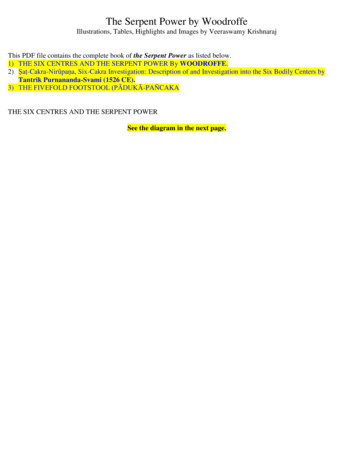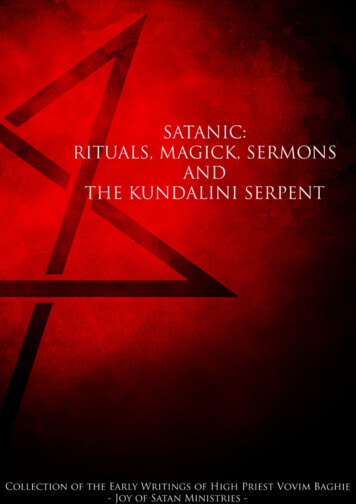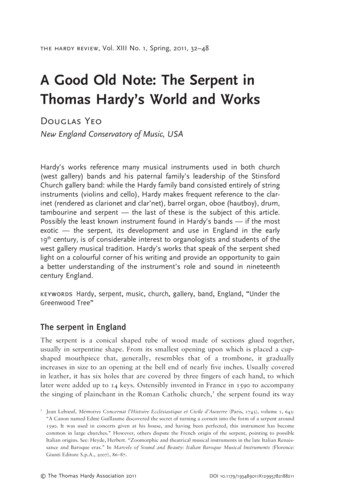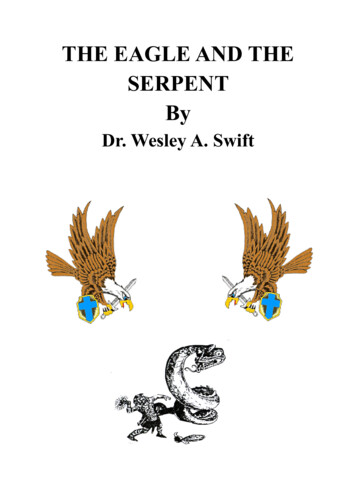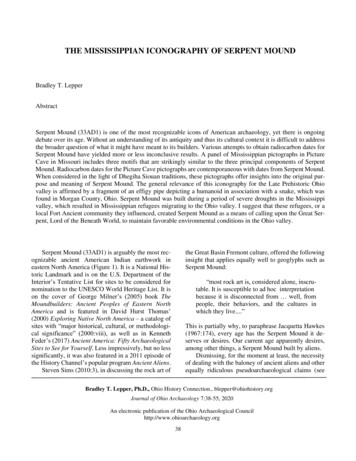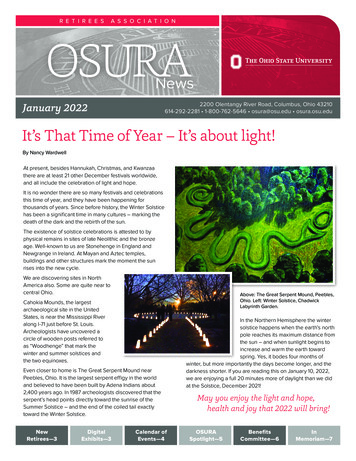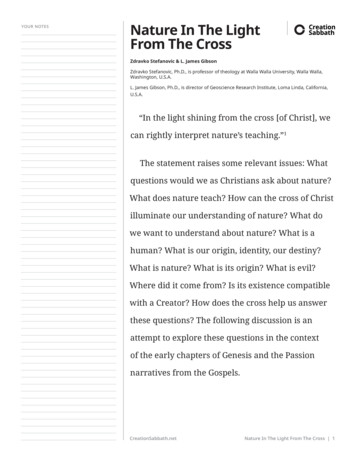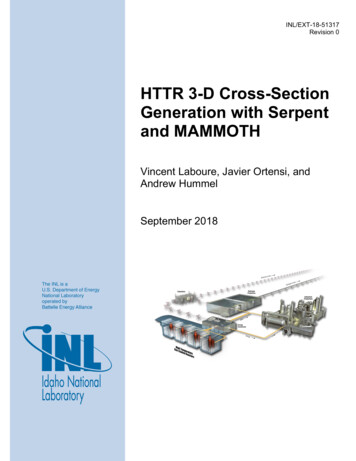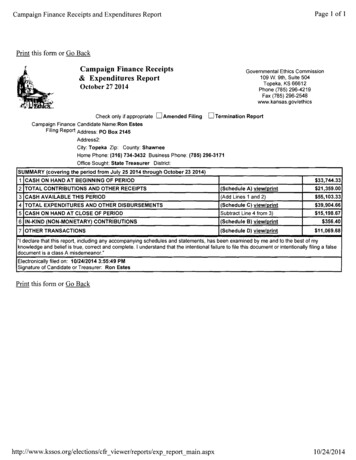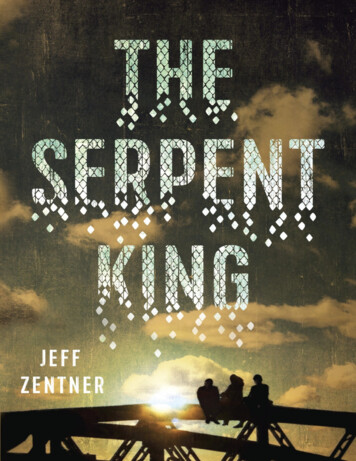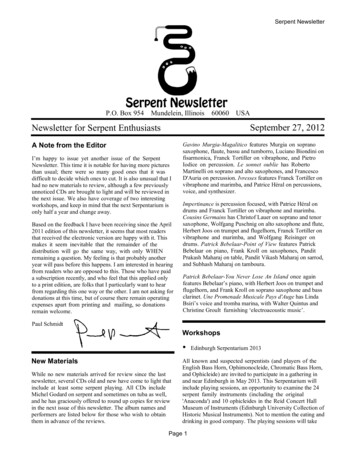
Transcription
Serpent NewsletterSerpent NewsletterP.O. Box 954Mundelein, Illinois60060USASeptember 27, 2012Newsletter for Serpent EnthusiastsA Note from the EditorI’m happy to issue yet another issue of the SerpentNewsletter. This time it is notable for having more picturesthan usual; there were so many good ones that it wasdifficult to decide which ones to cut. It is also unusual that Ihad no new materials to review, although a few previouslyunnoticed CDs are brought to light and will be reviewed inthe next issue. We also have coverage of two interestingworkshops, and keep in mind that the next Serpentarium isonly half a year and change away.Based on the feedback I have been receiving since the April2011 edition of this newsletter, it seems that most readersthat received the electronic version are happy with it. Thismakes it seem inevitable that the remainder of thedistribution will go the same way, with only WHENremaining a question. My feeling is that probably anotheryear will pass before this happens. I am interested in hearingfrom readers who are opposed to this. Those who have paida subscription recently, and who feel that this applied onlyto a print edition, are folks that I particularly want to hearfrom regarding this one way or the other. I am not asking fordonations at this time, but of course there remain operatingexpenses apart from printing and mailing, so donationsremain welcome.Gavino Murgia-Magalitico features Murgia on sopranosaxophone, flaute, bassu and tumborro, Luciano Biondini onfisarmonica, Franck Tortiller on vibraphone, and PietroIodice on percussion. Le sonnet oublie has RobertoMartinelli on soprano and alto saxophones, and FrancescoD'Auria on percussion. Ivresses features Franck Tortiller onvibraphone and marimba, and Patrice Héral on percussions,voice, and synthesizer.Impertinance is percussion focused, with Patrice Héral ondrums and Franck Tortiller on vibraphone and marimba.Cousins Germains has Christof Lauer on soprano and tenorsaxophone, Wolfgang Puschnig on alto saxophone and flute,Herbert Joos on trumpet and flugelhorn, Franck Tortiller onvibraphone and marimba, and Wolfgang Reisinger ondrums. Patrick Bebelaar-Point of View features PatrickBebelaar on piano, Frank Kroll on saxophones, PanditPrakash Maharaj on table, Pandit Vikash Maharaj on sarrod,and Subhash Maharaj on tamboura.Patrick Bebelaar-You Never Lose An Island once againfeatures Bebelaar’s piano, with Herbert Joos on trumpet andflugelhorn, and Frank Kroll on soprano saxophone and bassclarinet. Une Promenade Musicale Pays d'Auge has LindaBsiri’s voice and tromba marina, with Walter Quintus andChristine Groult furnishing ‘electroacoustic music’.Paul SchmidtWorkshopsŸNew MaterialsWhile no new materials arrived for review since the lastnewsletter, several CDs old and new have come to light thatinclude at least some serpent playing. All CDs includeMichel Godard on serpent and sometimes on tuba as well,and he has graciously offered to round up copies for reviewin the next issue of this newsletter. The album names andperformers are listed below for those who wish to obtainthem in advance of the reviews.Edinburgh Serpentarium 2013All known and suspected serpentists (and players of theEnglish Bass Horn, Ophimonocleide, Chromatic Bass Horn,and Ophicleide) are invited to participate in a gathering inand near Edinburgh in May 2013. This Serpentarium willinclude playing sessions, an opportunity to examine the 24serpent family instruments (including the original'Anaconda') and 10 ophicleides in the Reid Concert HallMuseum of Instruments (Edinburgh University Collection ofHistoric Musical Instruments). Not to mention the eating anddrinking in good company. The playing sessions will takePage 1
Serpent Newsletterplace in Carlops, a few miles outside Edinburgh, whereMurray and Patsy Campbell have their home.Accommodation is available at reasonable prices in the area.Accommodation is also available in Edinburgh. The dateswill be 24-27 May 2013, and a website has been establishedwith the latest information, www.homepages.ed.ac.uk/amThe provisional schedule of events is:Friday 24th MayAfternoon: arrive in Carlops; transport can be provided fromEdinburgh Waverley station by arrangement (buses from theairport go directly to Waverley)Evening: small group playing sessions, supperSaturday 25th MayAll day: group practice led by Phil HumphriesEvening: dinner at Allan Ramsay pubŸHistoric Brass Society 2012 SymposiumIn place of the usual Early Brass Festival, the HistoricBrass Society presented an international early brasssymposium in New York City from July 12 through 15.The event was held in three different venues of Manhattan;The New School, the Metropolitan Museum of Art, and theChurch of St. Luke in the Fields.Serpentists in attendance included Patricia Gauci fromCanada, Paul Schmidt and John Weber from Chicago,Craig Kridel from South Carolina, Doug Yeo fromArizona, Volny Hostiou from France, and Murray & PatsyCampbell and Arnold Myers from Scotland. However,serpents were hardly the focus of the event, and the usualnatural trumpets, natural horns, cornetts and sackbutspredominated.Sunday 26th MayMorning: small group playing sessions, lunchAfternoon: visit to the Reid Concert Hall Museum ofInstrumentsEvening: possible attendance at a concert in EdinburghMonday 27th MayMorning: possibility of individual lessonsAfternoon: group practice led by Phil HumphriesEvening: informal concert in CarlopsTuesday 28th MayMorning: depart, transport can be provided to EdinburghWaverley station by arrangementFor further information about the schedule and events, emailArnold Myers at A.Myers@ed.ac.ukFor details of accommodation, write to Murray Campbell atD.M.Campbell@ed.ac.ukOphicleide figurine from the Sue Bradley collectionRegretably, the symposium was organized so that thelectures were in opposing camps, so that participants wererequired to pick favorites, and nobody could attendeverything. Since this review is based on the experiences ofone participant, only those lectures and programs attendedin person will be mentioned.Thursday the 12th began with Brassiness Potential:Trombones Grow Nonlinear as Volume/Sound PressureLevel Increases, presented by Arnold Myers and MurrayCampbell. Next up was Design and Manufacture of 18thCentury Horns by Lisa Norman and John Chick. JohnMiller presented his paper Trumpet versus Cornet, and DonSmithers talked about Trajan’s Trumpets.Serpent figurine from the Sue Bradley collectionLater that morning, Michael Collver gave a presentation onunaccompanied cornetto, including Biber’s Passacagliaadapted from solo violin, Bassano’s Ricercata Seconda,and Bismantova’s Preludio per Cornetto. Next up was thegroup ¡Sacabuche! Italian 17th Century Motets withTrombone, performing Casati’s Laetare Syon, Cauda’sDomine Iesu Christe, three motets by Fillago, and Cauda’sBeatus vir.Page 2
Serpent NewsletterThat afternoon the concerts began with Grand Octuor poursix cors et deux trombones by Joseph Martin Mengal, andSextour pour six cors en different tons, Op. 10 by LouisFrançois Dauprat. The day ended with lectures by LindaPearse titled Seventeenth Century Italian Concerted Motetswith Specified Trombone Parts, and Joe Drew titled TheGreat Operatic Role for the Trumpet: KarlheinzStockhausen’s “Michael from Light”.Friday morning began with Herbert Heyde’s Presentationof Serpents and Low Brass Instruments of the MetropolitanMuseum Collection, followed by a concert held in theAndré Mertens Galleries for Musical Instruments. First onthe program was Jeff Snedeker on natural horn,accompanied by Kathryn Cok on fortepiano, performingGrande Sonate pour le pianoforte et cor, Op. 29 byFriedrich Eugen Thurner and Quatrième Divertissementpour cor et piano by Frédéric Duvernoy. Next was JaroslavRoucek on keyed trumpet with Maketa Knittlova on violinand Donsok Shin on fortepiano performing JohannNepomuk Hummel’s Trio for Trumpet, Violin and Piano,which if backed up by orchestra would be the famousTrumpet Concerto. There followed two more lectures,African Horns and Horn Ensembles given by IgnaceDeKeyser, and Joe Kaminski’s Asante Ivory Trumpets inPre-Colonial Military Religious Rites of Ghana.Musical instrument print from 1751After lunch, members of the Schola Cantorum BasiliensisTrumpet Ensemble presented a concert in the museumorgan loft, Spanish and Portugese Music in Imitation ofNatural Trumpets and Horns. The afternoon concluded withfive lectures and a concert-presentation. First was RaymondDavid Burkhart giving his paper American Women’s BrassQuartets Before 1900: ‘Clever, Versatile, and Fair to LookUpon’. Next was Arizona in Full Blast by Don Larry, andTrevor Herbert’s British Military Culture in the LongNineteenth Century. The next two lectures were on thesubject of serpents; Benny Sluchin’s Serpent Method Booksin France, First Half of Nineteenth Century and Thierry‘Chanteurs des Cours’ postcardManiguet’s The Evolution of the Serpent in the First Halfof the 19th Century – Looking for the Basson Russe!. Forserpentists, the highlight of the afternoon was the closingconcert-presentation given by Doug Yeo and VolnyHostiou. With brief spoken descriptions by Volny inbetween, the selections were Ave Maria Stella (plainsong),Oculus by Orlando di Lasso, Sonata “La Monica” byPhillipe Friedrich Böddecker, Domine Salvum Fac Regem(La Feillé from Méthode de plain chant, Paris, 1745),Allegro XI by Jean-Baptiste Métoyen, Andante by FrançoisGossec, and Duo 3 by Schiltz from his serpent method. Itwas a treat to finally meet Volny after hearing hisrecordings for the last several years.The day concluded with a concert at The Church of St.Luke in the Fields. First on the program was a set ofnatural trumpet fanfares led by Friedemann Immer andmembers of his “All Star” Natural Trumpet Fanfare,comprised of Immer himself, Barry Baugess, RobertCiviletti, John Foster, Juhani Listo, Jean-Françcois Madeuf,Jaroslav Roucek, and Crispian Steele-Perkins. Next was atrio with continuo comprised of Bruce Dickey on cornetto,Adam Woolf on trombone, Wouter Verschuren on dulcianand Kathryn Cok on harpsichord and organ, performingfourteen selections. The concert concluded with three largescale multi-choral works for cornetts and sackbuts,organized by Bruce Dickey and directed by GuntherSchuller. The players, forming up to four different choirslocated on either side of the balcony, at the altar and to theside of the sanctuary, was assembled mostly ‘by invitation’from the pool of professional players and some amateurones available at the symposium. The selections wereCanzon 18 a 14 by Giovanni Gabrieli, Canzon prima a 12by Giovanni Priuli, and Surrexit Christus a 16 by Gabrieli.Each choir had its own keyboard continuo, realized on twoportative organs, the main organ in the loft, and aPage 3
Serpent NewsletterSunday morning began with The Chemical Composition of16th Century Nuremburg Brass Musical Instruments,presented by Hannes Vereecke. Next, Sabine Klaus andArnold Myers gave a joint presentation The Disk Valve andIts Place in History, with their guest presenter CrispianSteele-Perkins playing some examples on a cornet equippedwith this type of valve. Adrian von Steiger then presentedhis paper Looking Through the Windows of [a] FrenchBrasswind Instrument Workshop.harpsichord. The charts were sight-read with only a fewstops to pick up the pieces here and there, and the musicwas indeed glorious. The evening concluded in thechurch’s social hall with the traditional pizza and beerparty.On Saturday morning, Jamie Savan started things off withhis lecture Straight Talking on the Origins of the Cornett,in which he described and demonstrated the transitionalinstrument that bridged the earlier animal horn and the latercornett. Depicted in iconography, this instrument seems atfirst to have too few finger holes while the players areinvariably shown with one hand over the ‘bell’ opening,and Jamie demonstrated how the capabilities of those holescan be extended through the device of hand stopping. FritzHeller then continued on the general subject with his talkon The Straight Cornetto. Keith Polk then gave another ofhis always engaging lectures, this time on The Inception ofthe Trombone Ensemble: A Revised Dating, and thenStewart Carter spoke on Blaset mit Posaunen – BrassPlaying in the Early Reformed Churches of Kanton Bern.Next on the schedule was a concert that began with cornetand trombone duets performed by Allan Dean and BennySlucin with piano accompaniment by Steven Plank. Theconcert then featured the group Les Sacqueboutuers –Ensemble de Cuivres Anciens de Toulouse, performingtheir program titled Ludi Musici (Musical Games). Later inthe day was a Conversation With Gunther Schuller, withTrevor Herbert as the interviewer. There followed acuriously misnamed roundtable discussion hosted byTrevor Herbert, listed in the program as an examination ofthe future of the Historic Brass Society. Disappointingly forthose in attendance who had expected a discussion on thefuture direction and focus of the HBS, the dialogue was inreality a group of college professors discussing their careersand whether it made sense to encourage students to pursuean education in the early brass field. The day’s eventsconcluded with a concert by His Majestys Sagbutts andCornett, interestingly performing a single contemporarypiece as opposed a more traditional program.The symposium concluded with a concert. First on theprogram was Crispian Steele-Perkins on slide trumpet withaccompaniment by Steven Plank. Next was a brilliantperformance by the group of natural horn students fromnorthern California, Trumpet Consort von Humbolt, lastseen at an HBS event years ago when the Early BrassFestival took place in Berkeley, California. Following was amass reading session for the natural trumpets, followed by asimilar session for natural horns. Then Bahb Civilettiperformed on natural trumpet, with recordedaccompaniment by Music Minus One, playing a concerto byGeorge von Reutter II. John Foster on natural trumpet withSteven Plank on organ were then heard, and the concertconcluded with Ralph Dudgeon on keyed bugle, again withaccompaniment by Steven Plank, performing C. EugéneRoy’s Thème and Variations sur un air d’Etienne NicholasMèhul, the extensively titled Ombra che a mi ritorna –Cavatina tirée ‘Gabriella di Vergi’ by Michel EnricoCarafu di Colobrano, and a Caprice. At the conclusion ofthe concert, the Christopher Monk Award was presented tolast year’s winner, instrument maker Rainer Egger, and the2012 winner, Kenneth Kreitner. Organizer Jeff Nussbaumthen received a long round of applause.Volny Hostiou wrote the following impressions of thesymposium.The HBS Symposium took place this year, 2012, in NewYork City, and the Big Apple met the serpent! In the midstof various subjects about brass organology, repertories andpractice, the serpent session took place in the MetropolitanMuseum. Introduced by Craig Kridel, it begin with aPage 4
Serpent Newsletterpresentation by professor Herbert Heyde who showed ussome interesting pieces from the MET collection. Whatheld my attention was a little serpent with a very little bore,maybe not a serpent played with a mouthpiece but probablywith a double reed; was it the instrument used by Mozart asRenato Meucci proposed in his paper Les 'serpentini'utilisés par Mozart à Milan, Renato Meucci, 2004,Musique Images Instruments, Volume 6? It looked probablytoo poorly realized to be a real played instrument, soperhaps it was a prototype for a new kind of instrument?In the museum store room I saw a French serpent, thisanonymous instrument seemed to have the samecharacteristics as the serpent copied by Stephan Berger(E.02204) from the Paris Music Museum. Severalinstruments in Basel museums and Michel Godard’scollection are similar, so maybe they are from the samemaker?the Jura Mountains in Switzerland. The occasion was aspecial workshop attended by 24 musicians of all ages andwalks of life, mostly professionals – teachers, performers, apriest, an organist, conservatory director, military bandsman,etc. – who converged from various parts of Switzerland andfrom Germany and France, to a large, solitary seminar housenot far from the town of Saignelegiers. There they spent fourdays filling the air with that special warm and breathy soundof the grand old instrument, while exploring technical andmusical fine points under the guidance of three of theinstrument’s great performers and teachers: Michel Godardand his two former students, Volny Hostiou and PatrickWibart.Benny Sluchin (trombone player in IRCAM) made a verycomplete study about French serpent methods and gave adetailed catalog of the different exercises, pieces, and duetsused by the authors in the project to write pedagogicalbooks for serpent students in the 19th century. ThierryManiguet (curator in Paris Music Museum) presented apaper about serpent classification and organologicalevolution in the 19th century, he pointed out specially theplace of the bass horn and basson russe in the history of theserpent.The serpent session concluded with a concert in duet byDouglas Yeo and myself. We performed a program withduets from the European Renaissance music to 19th centurywith some examples from serpent methods.Caricature from ‘Army and Navy’by Major T S Seccombe. Published byFrederick Warne & Co. Dates c 1873.“B is a Bandsman; how sweet to reclineOn the turf, close beside the gay Bandsman, when fine,And drink in the silvery strains as they passThrough the soft summer air from his six feet of brass.But pleasure has pain, and sometimes, you must know,Though in harmony gentle, sweet music may flow,Some instruments take great exertion to blow.”Doug Yeo and Volny Hostiou at the HBS SymposiumŸReport on Workshop in the Jura Mountainsby Marton RadkaiSerpent RisingWho knows where and when the serpent will surface at anygiven time? At the end of March, it was in the pristine air ofThe workshop was organized by local craftsman StephanBerger and his wife Erna Suter with the help of the localcommunication specialist Claude Donzé. It took a year ofhard work getting sponsors and coordinating with theteachers, but in the end all the elements came togetherperfectly. "I was surprised by the fact that there were somany young musicians as well," says Berger, looking back atthe four-day serpent fest. "I also found it fascinating toobserve the ease with which these teachers taught these largegroups.” Berger, who runs the Atelier de Cuir, a leatherworking operation, and is something of an inventor on theside – one of his latest creations is a very successful harnessfor guide dogs for the blind – was one of the students. Hehas his own special history with the serpent, and may havewritten himself indelibly into the history of the instrument.Page 5
Serpent NewsletterSix years ago, Godard approached him with a request: torestore and rebuild his instrument. In the process, Bergerstarted learning the instrument as well, no mean feat forsomeone who had no previous experience playing anyinstrument. Not only did he complete the project forGodard, but he went even farther and began buildinginstruments himself out of carbon composite. For Godard,who has devoted over two decades to the instrument, theavailability of a high-quality and affordable instrument iscrucial for the resurgence of the serpent.Community SpiritMany who had become smitten with the instrument felt theycould only reach a certain level alone or given the means attheir disposal. “I had tried earlier on to get tips from tubaplayers and trombonists,” said Meike Herzig, a professionalrecorder player from Cologne. She had even contacted azink (cornetto) player who was unable to even get a soundout of the instrument. “That’s why this meeting was soimportant for me,” she says. “It was encouraging to see thatothers who are working with the serpent have the sameproblems, with the sonority of some of the more difficultnotes, for example, and then to hear how the pros solve thevery same problems ” She took her lessons learned backhome and has started accompanying voice students at theDüsseldorf conservatory, thus using the instrument in itsoriginal function. Hostiou, from the perspective of theteacher, experienced this enthusiasm as a powerfulcommitment and their openness to the different repertoirestouched upon. “Once again, I noticed the strong sense ofpluralism in the world of serpentists", he said. "Each iswilling to bring a new brick rather than copy what everyoneelse is doing. It’s one of the particularities of this instrumentthat has no real ‘school’ and allows all types of expression."For Michel Godard, the sheer number of players who hadshown up was amazing. “Twenty years ago, you couldbarely hear a serpent," he pointed out in an interview."There were a few devotees in England, but you couldn’tfind anyone in France or Germany."L-R: Patrick Wibart, Michel Godard, Stephen Berger,Volny Hostiou at the Jura Mountains workshopThe workshop, titled The Serpent’s Journey, was dividedinto areas of specialty. Wibart explored some of the basictechnical aspects of the instrument, such as how to adjustpitch, close the holes properly, or even produce certainnotes. He also took his classes through the intricacies ofplaying contemporary music, which requires a host ofspecial techniques. Volny Hostiou, for his part, shared aparticular specialty especially for performers interested insome of the rarer aspects of ancient music: the skill ofimprovisation in the baroque age. As for Michel Godard,one of his areas of focus was the art of jazz improvisation.It was an exciting and intense moment for all concerned.Swiss press and television made its way up to the lonelyridge known as the Free Mountains to broadcast news of theevent beyond the region. What they found was a group ofenthusiasts all passionate about this almost esotericinstrument, eager to learn more about it but equally eager tomeet kindred spirits and share personal experiences –networking, to use a modern word. This, at any rate, wasone of the often heard comments made by the participantsduring a stock-taking hour on the final day.Group playing session at Jura Mountains workshopIn the OpenFor all participants, the climax of the workshop wasundoubtedly the concert at the Café du Soleil inSaignelegiers, a hub of cultural life whose reputationextends well beyond the region’s borders. Before a packedhall, the 24 ‘students’ opened up on all mouthpieces with aseven-part canon on the cantus firmus Ave Maris Stella,written by Gioanpietro Del Buono, an Italian composer ofthe mid-17th century, and directed by Volny Hostiou. Theconcert then proceeded with solos and duets by Hostiou andWibart occasionally accompanied by violinist FannyPage 6
Serpent NewsletterPaccoud and the young theorbist Bruno Helstroffer. Hostioujoined Wibart in Domine, salvum fac regem by de la Feilléand a Ciaccona by Falconieri, and went solo with the Sonatasopra la Monica by the 17th-century German organist andcomposer Friedrich Philipp Böddecker. Wibart thendemonstrated new colorings and delicate percussive effectswith several contemporary works, notably an excerpt fromChers Trembles by the French composer Gerard Pesson.After a brief intermission, Godard came on stage togetherwith the stunning Sardinian saxophone player and vocalistGavino Murgia, whose sepulchrally deep voice opened thesecond part like some herald from another world. It was afeast mixing old music with new. Each musician had thespace and time to express him- or herself, to accompany, orshine as a soloist, while Godard calmly held the stagetogether with his smooth, majestic serpent sound . He playeda number of pieces from his latest album, which features themusic of Monteverdi in part dissembled and thenreassembled, ornamented not with fancy mordants and trills,but rather daring rhythms, experimental and jazzyharmonies, spontaneous musical meditations. Among thepieces, the famous duet Pur ti miro from L'incoronazione diPoppea, and the madrigal Zefiro torna. These alternatedwith a number of his own works, exotic Ambre, the movingA Trace of Grace, and the Prelude in F.For the grand finale, the 24 serpents returned to the stage fora rousing Reggae des serpents by Godard, the swingingCome On DH by Eddy Louis, during which two of thestudents had a chance to test their improvisational skills,and, finally Lyoba, hymn for cows from the neighboringcanton of Fribourg (famous for Gruyère cheese and extrathick cream). The tongue-in-cheek arrangement was writtenby local trumpet wizard, Tennessee-born Bill Holden. It wasa fitting and humorous conclusion to a concert devoted tothe instrument about which composer- comedian PeterSchickele once wrote through his avatar P.D.Q. Bach, "Itlooks like a snake and sounds like a cow." The excitement ofthe group was palpable till the last minute, and promises tocarry over to the next workshop, which has not beenscheduled as of yet. Suffice to say, the location is excellent,at the crossroads of Germanic and Latin Europe, and it ispropitious to hard and productive work. The air is clear, thelandscapes broad and inspiring. And the gifts of the table,donated by local bakers, butchers, cheese makers andbrewers and prepared by the amazing Gert Hollwurtel ,ensure that body and soul are kept together during the longhours of practice.Musical instrumentprint from 1897Getting SerpentsHere is the list of Serpent makers who have made themselves known to us.Many instruments are available through dealers, and all makers will dealdirectly with individual customers.Christopher Monk Instruments(c/o Nicholas Perry)224 North StreetLutonLU2 7QNEnglandDerek Farnell82 Crumpsall LaneManchester M8 5SGEnglandPhone: 44 (0)1617 407778(ophicleides)Phone: 44 (0)1582 457 992 nicholas@perry2185.freeserve.co.uk Wetter/Berger Serpents(serpents, early cimbasso, bass horns) Stephen BergerCH-2336 Les BoisDavid Harding (by EMS BradfordPhone: 0041 (0) 3296 11188order here)Matthias WetterThe Early Music ShopCH-8475 Ossingen38 Manningham LanePhone: 0041 (0) 5231 73184BradfordSwitzerlandWest Yorkshire BD1 3EAEngland info@serpentmakers.ch Phone: (44) 01274 393753 www.wetterberger.ch www.e-m-s.com www.serpentmakers.ch sales@earlyms.demon.co.uk (alphorns and serpents, both wood(resin serpents)and carbon fiber)Serpents Ribo(c/o Pierre Ribo)Rue Van Oost, 401030 BruxellesBelgiumPhone: 0032 497 574 496EnglandChristopher Monk Instruments(c/o Jeremy West) 44 (0)1388 526999 www.jeremywest.co.uk/cmi/ hmcornett@gmail.com pierre.ribo@ souslesplatanes.be Sam Goble Historical Mouthpiecesphone: 44 (0) 77 8056 4370 www.samgoble.com info@samgoble.com (cornett and serpent mouthpieces)(serpents)Kaiser Serpentshttp://www.kaiserserpents.com(fiberglass serpents after Baudouin)Serpentones LopezJuan Lopez Romera, makerhttp://serpenton.com/(wooden serpents & cornetti)Page 7(cornetti)Build an experimental serpentfrom plans via www.serpentwebsite.com
Serpent NewsletterWhere Serpents GatherŸCanadian ophicleidian Gary Nagels related hisadventures in adding serpent to his stable of instruments,using an instrument by Kaiser. Travails included startingwith an ophicleide mouthpiece only to find it poorly suited,then explorations into available serpent mouthpieces, as wellas finding an appropriate bocal for the historical tunings ofthe group(s) he is playing with. He also plans to travel toEurope in search of more instruments and to hopefully meetwith some of the established fine players there.Gary has been in touch with Craig Kridel and received somegood advice about tuning the serpent to the historic pitchstandards used by the plainchant group he has been workingwith. Gary writes, “I will have Kaiser make me a specialbocal and see how that works. New mouthpieces are comingfrom JC Sherman and I am thinking about getting in touchwith Nicholas Perry about a Monk serpent.”knows anyway, although it did include a few tidbits aboutserpents in New France. In the concert portion of the talk mybrother Lance, a tuba player, was there to help. We playedsome duets on serpent & tuba and ophicleide & tuba toshow the evolution of the sound change through thecenturies. It was a great success for a first try and I am outlooking for other opportunities to play. I've been out of theearly music scene for too long and it feels good to be back.”ŸLeonard Byrne wrote about playing an ophicleide solo,A Song for Japan by Steven Verhelst, in front of the localBritish brass band this last spring. A video has been postedon YouTube athttp://www.youtube.com/watch?v oNIVer8y5 4Gary wrote about his first serpent performances, “Theconcert we played was part of a seminar in Montreal held onthe weekend of August 17-19, 2012. It was for theGregorian Institute of Canada. Here's the link on the event;www.gregorian.ca/eng/news.php. The talk went well and theconcert was well attended. I didn't realize there was thatmuch interest in Gregorian chant. It was held in the verylarge church in downtown Montreal, the Gesù-Centre deCréativité with a very lively acoustic.”“The talk had a working title Histoire et évolution duserpent à l'ophicleide, musique sacré, populaire etorchestrale du 16e au 19e siècle, or in English The Historyand Evolution of the Serpent and Ophicleide in Sacred,Popular and Orchestral Music from the 16th-19 Century. Along title but it sort of encompassed everything. Theaudience were plainchant enthusiasts mostly from Canada.There were some Europeans and I think a few from theStates. The talk was given in French; I can write an Englishversion of the talk but it's all information that everyoneŸThe Stölzel Chamber Ensemble performed two concertson June 29 and July 1, 2012, in Bonn, Germany, ofunpublished cantatas by Gottfried Heinrich Stölzel (acontemporary of J.S. Bach). The program included Bist Dubei mir, Aria in C minor (later adapted by Bach), GermanMass in E minor, Cantata in Bb major ‘Wohltun ist wie eingesegneter Garten’ for the Fou
newsletter, several CDs old and new have come to light that include at least some serpent playing. All CDs include Michel Godard on serpent and sometimes on tuba as well, and he has graciously offered to round up copies for review in the next issue of this newsletter. The album names and
